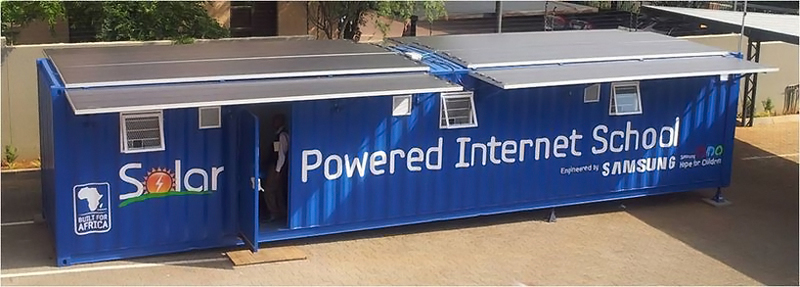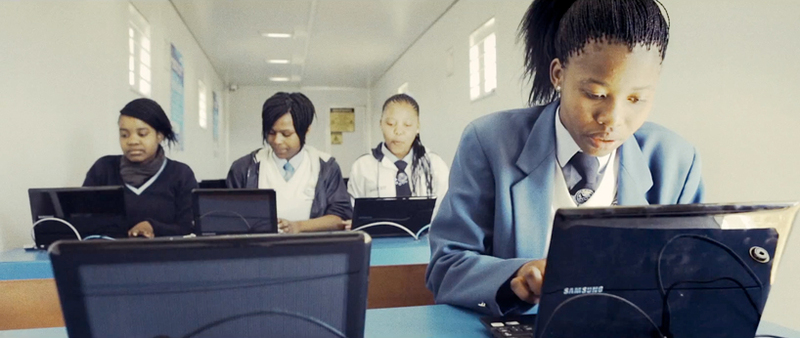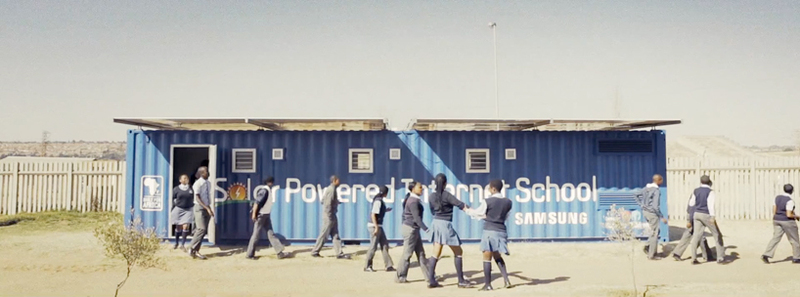Friday Good Post or How Samsung Builds Solar-Powered Internet Schools
Have you ever heard of the solar-powered Internet school? Solar Powered Internet School is a very original project organized by Samsung. Its goal is to help children from distant corners of the planet in learning and gaining access to modern technology. The first solar-powered mobile class appeared a year ago in the small village of Phomolong, in the suburbs of Johannesburg, the capital of South Africa. Recently, this development was awarded as the best solar project of the year at the Africa Energy Awards.

Thierry Boulanger, head of Samsung’s South African division for IT projects, said that only a small fraction of such projects have been successfully commissioned because only 25% of the country's population has access to electricity. This contributes to the creation of isolated communities that do not have modern educational institutions and communication channels, which, in turn, extremely negatively affects the development of these regions. Boulanger described the Solar Powered Internet School project as "a mobile and completely independent classroom, the equipment in which works exclusively on solar energy." Its pilot version "aims to increase access to education and expand telecommunications opportunities throughout Africa."
What is a mobile classroom like? In fact, this is a 12-meter container. But not simple, butgoldenspecial. It is powered by solar panels mounted on the roof and sides. The batteries themselves are also unusual: made of rubber-like material, which greatly simplifies their transportation without the risk of damage. They generate up to 9 hours of electricity per day, powering all classroom equipment. Inside, the room is equipped with a 50-inch interactive whiteboard, laptops powered by solar energy and Internet access, Samsung GALAXY tablets, and Wi-Fi cameras that take class photos every 15 seconds. At the same time, the mobile class can accommodate up to 21 students, all educational materials from zero to twelfth grade are stored on a central server.

According to Boulanger, in the process of developing the project, three key priorities were taken into account: the container should be stable and reliable, not dependent on the mains and have safety and control equipment on board.
Solar panels are more durable than conventional ones due to the rubberized component in their structure. The stored energy storage system was refined: instead of vessels with sulfuric acid (H2SO4) diluted with distilled water, it uses lead-acid batteries with an electrolyte in the form of a gel. This was done in order to prevent the leakage of hazardous substances during transport. Also on the panels there are special sensors with which you can track their location in case of theft.
In order to avoid the temptation to unauthorizedly connect to an independent power source in the middle of a remote countryside (all kinds of teapots and televisions), all power sources were placed at the bottom of the batteries. If someone nevertheless decides to stick the crazy hands where they should not, the security system will immediately send a signal to the operator who is monitoring this object.

It's no secret that the African sun is the hottest on the planet. A few hours in an ordinary metal container under the local midday sun may not have the best effect on health and life. Samsung engineers solved this problem by equipping a mobile classroom with a 10-cm layer of thermal insulation and exhaust ventilation to ensure a comfortable microclimate inside. Solar panels also play a role in cooling the room, taking the brunt of direct sunlight on themselves and acting as a kind of umbrella for the container. Thanks to all these solutions, the temperature difference inside and out is ten degrees.
The container is transportable: it can be loaded onto a truck and transported to anywhere in the country, regardless of remoteness.

The director of the school, Mocheke Toka, says that the school in Fomolong is the only educational institution in the territory with a population of more than 350 thousand people. It is designed to educate 1,200 children, but currently accommodates 1972 students. More than 500 of them are orphans, and even those children who have parents often can not afford to pay for education. 70 teachers teach at the school, additional classes are held day and evening, and free meals for 1,500 students are provided.
Toka also noted that the new solar-powered Internet class has enabled school students to discover a whole new world. Now they can use the Internet both in school and in their free time, if it is necessary to work on their training projects.

Thierry Boulanger believes that the creation of solar-powered Internet schools in South Africa will help solve many of the socio-economic problems of this region: “Now we are moving from“ Here is a laptop, here is an order, here is a price ”to“ Here is an affordable solution. ”
The Solar Powered Internet School initiative will evolve: Samsung plans to install dozens of containers in other regions of the country and provide affordable technology to more than five million African students by 2015.
Video:

Thierry Boulanger, head of Samsung’s South African division for IT projects, said that only a small fraction of such projects have been successfully commissioned because only 25% of the country's population has access to electricity. This contributes to the creation of isolated communities that do not have modern educational institutions and communication channels, which, in turn, extremely negatively affects the development of these regions. Boulanger described the Solar Powered Internet School project as "a mobile and completely independent classroom, the equipment in which works exclusively on solar energy." Its pilot version "aims to increase access to education and expand telecommunications opportunities throughout Africa."
What is a mobile classroom like? In fact, this is a 12-meter container. But not simple, but

According to Boulanger, in the process of developing the project, three key priorities were taken into account: the container should be stable and reliable, not dependent on the mains and have safety and control equipment on board.
Solar panels are more durable than conventional ones due to the rubberized component in their structure. The stored energy storage system was refined: instead of vessels with sulfuric acid (H2SO4) diluted with distilled water, it uses lead-acid batteries with an electrolyte in the form of a gel. This was done in order to prevent the leakage of hazardous substances during transport. Also on the panels there are special sensors with which you can track their location in case of theft.
In order to avoid the temptation to unauthorizedly connect to an independent power source in the middle of a remote countryside (all kinds of teapots and televisions), all power sources were placed at the bottom of the batteries. If someone nevertheless decides to stick the crazy hands where they should not, the security system will immediately send a signal to the operator who is monitoring this object.

It's no secret that the African sun is the hottest on the planet. A few hours in an ordinary metal container under the local midday sun may not have the best effect on health and life. Samsung engineers solved this problem by equipping a mobile classroom with a 10-cm layer of thermal insulation and exhaust ventilation to ensure a comfortable microclimate inside. Solar panels also play a role in cooling the room, taking the brunt of direct sunlight on themselves and acting as a kind of umbrella for the container. Thanks to all these solutions, the temperature difference inside and out is ten degrees.
The container is transportable: it can be loaded onto a truck and transported to anywhere in the country, regardless of remoteness.

The director of the school, Mocheke Toka, says that the school in Fomolong is the only educational institution in the territory with a population of more than 350 thousand people. It is designed to educate 1,200 children, but currently accommodates 1972 students. More than 500 of them are orphans, and even those children who have parents often can not afford to pay for education. 70 teachers teach at the school, additional classes are held day and evening, and free meals for 1,500 students are provided.
Toka also noted that the new solar-powered Internet class has enabled school students to discover a whole new world. Now they can use the Internet both in school and in their free time, if it is necessary to work on their training projects.

Thierry Boulanger believes that the creation of solar-powered Internet schools in South Africa will help solve many of the socio-economic problems of this region: “Now we are moving from“ Here is a laptop, here is an order, here is a price ”to“ Here is an affordable solution. ”
The Solar Powered Internet School initiative will evolve: Samsung plans to install dozens of containers in other regions of the country and provide affordable technology to more than five million African students by 2015.
Video:
